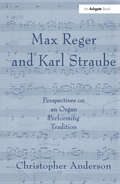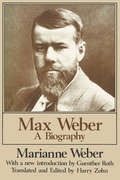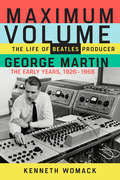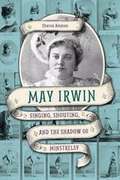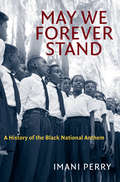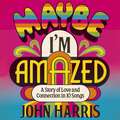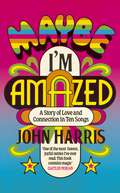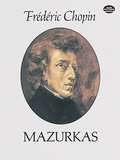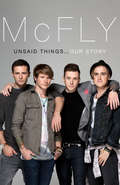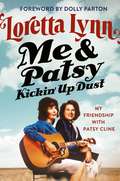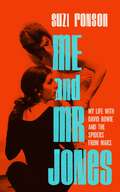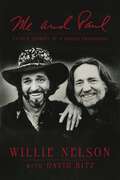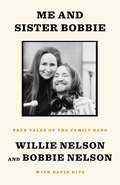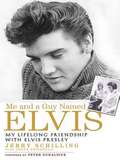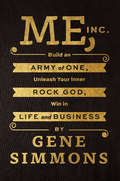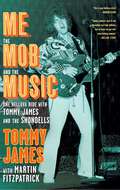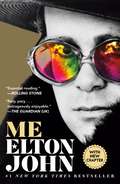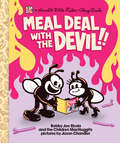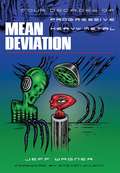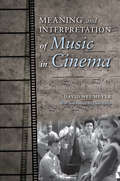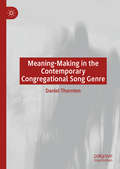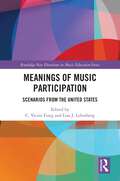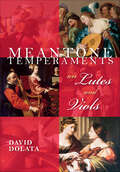- Table View
- List View
Max Found Two Sticks
by Brian PinkneyIt was a day when Max didn't feel like talking to anyone. He just sat on his front steps and watched the clouds gather in the sky. A strong breeze shook the tree in front of his house, and Max saw two heavy twigs fall to the ground.
Max Reger and Karl Straube: Perspectives on an Organ Performing Tradition
by Christopher AndersonMax Reger (1873-1916) is perhaps best-known for his organ music. This quickly assumed a prominent place in the repertory of German organists due in large measure to the efforts of Reger‘s contemporary Karl Straube (1873-1950). The personal and collegial relationship between the composer and performer began in 1898 and developed until Reger‘s death. By that time, Straube had established himself as an important artist and teacher in Leipzig and the central authority for the interpretation of Reger‘s organ music. The Reger-Straube relationship functioned on a number of levels with decisive consequences both for the composition of the music and its interpretation over a period fraught with upheaval on sociopolitical, religious and aesthetic fronts. This book evaluates the significance of the relationship between the composer and organist using primary source materials such as autograph performing manuscripts, reviews, programmes, letters and archival sources from contemporary organ building. The result is a much enhanced understanding of Reger in terms of performance practice and reception history, and a re-examination of Straube and, more broadly, of Leipzig as a musical centre during this period.
Max Weber: A Biography
by Marianne WeberA founder of contemporary social science, Max Weber was born in Germany in 1864. At his death 56 years later, he was nationally known for his scholarly and political writings, but it was the international reception of his oeuvre over the last forty years that has made him world-famous. "The Protestant Ethic and the Spirit of Capitalism," "The Economic Ethics of the World Religions" and his magnum opus, "Economy and Society," with its treatment of the relations of economics, politics, law and religion, belong to the great achievements of 20th-century social science.The groundwork for the posthumous Weber reception was laid by Weber's widow Marianne, a well-known feminist writer, who followed up her edition of his collected works with one of the greatest biographies in a generation that produced many important accounts of itself. Although unavailable in English until a decade ago, the importance of Marianne Weber's 1926 work had been widely understood. Sociologist Robert A. Nisbet called it "a moving and deeply felt biographical memoir." Historian Gerhard Masur cited the book as "the foundation of all further inquiries into Max Weber's life and influence."Beginning with Max's ancestry and early years, Marianne Weber guides us through his life as student, young lawyer, scholar and political writer, quoting liberally from his voluminous correspondence. Her account of his nervous breakdown after 1897, which curtailed his academic career but ultimately strengthened his creative energies, provides deep insight into some of the personal tensions that troubled him to the end. In addition to her perceptive personal and intellectual life before the First World War, describing many scholars, social reformers, politicians and literary figures within and beyond the famous Heidelberg circle of the Webers. The new introduction by Guenther Roth situates Marianne Weber's own role in the contemporary setting and discusses the current state of Weber research and of the
Maximum Volume: The Life of Beatles Producer George Martin, The Early Years, 1926–1966
by Kenneth WomackMaximum Volume offers a glimpse into the mind, the music, and the man behind the sound of the Beatles. George Martin's working-class childhood and musical influencesprofoundly shaped his early career in the BBC's Classical Music department and as head of the EMI Group's Parlophone Records. Out of them flowed the genius behind his seven years producing the Beatles' incredible body of work, including such albums as Rubber Soul, Revolver, Sgt. Pepper's Lonely Hearts Club Band, and Abbey Road.The first book of two, Maximum Volume traces Martin's early years as a scratch pianist, his life in the Fleet Air Arm during the Second World War, and his groundbreaking work as the head of Parlophone Records, when Martin saved the company from ruin after making his name as a producer of comedy recordings. In its most dramatic moments, Maximum Volume narrates the story of Martin's unlikely discovery of the Beatles and his painstaking efforts to prepare their newfangled sound for the British music marketplace. As the story unfolds, Martin and the band craft numerous number-one hits, progressing toward the landmark album Rubber Soul—all of which bear Martin's unmistakable musical signature.
May Irwin: Singing, Shouting, and the Shadow of Minstrelsy
by Sharon AmmenMay Irwin reigned as America's queen of comedy and song from the 1880s through the 1920s. A genuine pop culture phenomenon, Irwin conquered the legitimate stage, composed song lyrics, and parlayed her celebrity into success as a cookbook author, suffragette, and real estate mogul. Sharon Ammen's in-depth study traces Irwin's hurly-burly life. Irwin gained fame when, layering aspects of minstrelsy over ragtime, she popularized a racist "Negro song" genre. Ammen examines this forgotten music, the society it both reflected and entertained, and the ways white and black audiences received Irwin's performances. She also delves into Irwin's hands-on management of her image and career, revealing how Irwin carefully built a public persona as a nurturing housewife whose maternal skills and performing acumen reinforced one another. Irwin's act, soaked in racist song and humor, built a fortune she never relinquished. Yet her career's legacy led to a posthumous obscurity as the nation that once adored her evolved and changed.
May We Forever Stand: A History of the Black National Anthem (The John Hope Franklin Series in African American History and Culture)
by Imani PerryThe twin acts of singing and fighting for freedom have been inseparable in African American history. May We Forever Stand tells an essential part of that story. With lyrics penned by James Weldon Johnson and music composed by his brother Rosamond, "Lift Every Voice and Sing" was embraced almost immediately as an anthem that captured the story and the aspirations of black Americans. Since the song's creation, it has been adopted by the NAACP and performed by countless artists in times of both crisis and celebration, cementing its place in African American life up through the present day. In this rich, poignant, and readable work, Imani Perry tells the story of the Black National Anthem as it traveled from South to North, from civil rights to black power, and from countless family reunions to Carnegie Hall and the Oval Office. Drawing on a wide array of sources, Perry uses "Lift Every Voice and Sing" as a window on the powerful ways African Americans have used music and culture to organize, mourn, challenge, and celebrate for more than a century.
Maybe I'm Amazed: A Story of Love and Connection in Ten Songs
by John HarrisIn this extraordinary memoir, a father tells the story of how music has opened up the world to his son, one song at a time.Obsessed with music since he was a child, John Harris had no idea that he was in fact preparing himself for the greatest challenge of his life. But so it transpired. When his son James was born, and three years later diagnosed with autism, music became a source of precious connection and endless wonder for both of them.Maybe I'm Amazed describes how the music of The Beatles, Kraftwerk, Funkadelic, The Velvet Underground, Amy Winehouse and many more were soon woven into the fabric of James's life, becoming an essential part of who he is. It takes us through the struggles of raising an autistic child in a prejudiced world, and uncovers a hidden history of neurodivergence and creativity that casts new light on why notes, chords and lyrics speak so powerfully to the human mind.Anyone who has fallen in love with a band or heard their life reflected back to them by a song will recognise themselves in the story of this father and his son. And in considering the intense and transcendent way James absorbs and connects with music, it has lessons in listening and living for us all.
Maybe I'm Amazed: A Story of Love and Connection in Ten Songs
by John HarrisIn this extraordinary memoir, a father tells the story of how music has opened up the world to his son, one song at a time.Obsessed with music since he was a child, John Harris had no idea that he was in fact preparing himself for the greatest challenge of his life. But so it transpired. When his son James was born, and three years later diagnosed with autism, music became a source of precious connection and endless wonder for both of them.Maybe I'm Amazed describes how the music of The Beatles, Kraftwerk, Funkadelic, The Velvet Underground, Amy Winehouse and many more were soon woven into the fabric of James's life, becoming an essential part of who he is. It takes us through the struggles of raising an autistic child in a prejudiced world, and uncovers a hidden history of neurodivergence and creativity that casts new light on why notes, chords and lyrics speak so powerfully to the human mind.Anyone who has fallen in love with a band or heard their life reflected back to them by a song will recognise themselves in the story of this father and his son. And in considering the intense and transcendent way James absorbs and connects with music, it has lessons in listening and living for us all.
Mayo Clinic Guide to a Healthy Pregnancy
by Myra J. WickAn essential pregnancy resource for all parents-to-be. Mayo Clinic Guide to a Healthy Pregnancy, second edition is an authoritative, yet practical reference manual from the pregnancy experts at the #1 ranked hospital in America. The newly updated book includes information on everything from healthy lifestyle habits to the latest technologies in prenatal care and childbirth. Features include week-by-week updates on baby&’s growth, as well as month-by-month changes that mom can expect. In addition, you&’ll find a forty-week pregnancy calendar, an overview of common pregnancy symptoms, information on safe medicine use, tools to help parents with important pregnancy decisions, and general caregiving advice—information moms and dads can trust to help give their little ones a healthy start. Mayo Clinic Guide to a Healthy Pregnancy, second edition is the collective effort of a team of health care experts who find nothing in medicine more exciting and satisfying than the birth of a healthy child by a healthy mother. Any parent-to-be looking for accurate and authoritative information from a reliable source will surely appreciate this illustrated, easy-to-understand book.
Mazurkas (Dover Classical Piano Music)
by Frédéric ChopinAmong the best-loved and most performed of Chopin's piano compositions are his mazurkas. This volume includes 51 works -- remarkable for their wide emotional appeal, advanced choromatic techniques and pianistic devices, and ranging in difficulty from relatively easy, for advanced beginnings, to quite challenging, for the accomplished pianist.Edited by Carl Mikuli, a pupil of Chopin, the works in this inexpensive and attractive volume extend from the radiant joyfulness of the Mazurka in B-flat major, Op. 7, No. 1, to the aching sadness of the Mazurka in A minor, Op. 17, No. 4, and from the brevity of the Mazurka in E-flat minor, Op. 6, No. 4, to the breadth of the C-sharp minor Mazurka, Op. 50, No. 3.Pianists and music lovers will welcome this attractive, sturdy volume reproduced directly from the authoritative Kistner edition. It comprises a treasury of Chopin's most characteristic and appealing works in one convenient, inexpensive source.
McFly - Unsaid Things...Our Story
by Tom Fletcher Danny Jones Harry Judd Dougie PoynterThe intimate - and surprising - autobiography of Britain's most adored bandPrepare to meet the real McFly …In 2003, Tom Fletcher, Danny Jones, Harry Judd and Dougie Poynter came together and formed what would become one of the most popular and successful bands in the UK. Just teenagers at the time, they were catapulted into the limelight and had to adapt quickly to their new-found fame – and everything that came with it. Now, at last, they have decided to tell their story, in full and revealing detail.Speaking with candour and their trademark humour, Tom, Danny, Harry and Dougie share both the stories of their own lives and that of McFly. They give their personal insights into their contrasting childhoods, the individual paths that led them to the band, the struggles they have each overcome, their love lives and, of course, their music.Packed with previously untold stories, a lot of laughter and the occasional tear, Unsaid Things offers a privileged look into the lives of four guys who started out as bandmates and became best friends. Their unique camaraderie radiates from every page and by the end of the book, you’ll know them almost as well as they know each other … Tom Fletcher, Danny Jones, Harry Judd and Dougie Poynter have been together as McFly since 2003. They hold the record for being the youngest band to have a debut No 1 album in the UK. Their hits include: 'Five Colours in Her Hair', 'All About You', 'Please, Please' and 'Shine a Light'. They are one of the biggest bands in the UK.
Me & Patsy Kickin' Up Dust: My Friendship with Patsy Cline
by Loretta Lynn Patsy Lynn RussellMe & Patsy Kickin' Up Dust shares the"important and inspiring" (Miranda Lambert) never-before-told complete story of the remarkable relationship between country music icons Patsy Cline and Loretta Lynn. Loretta Lynn and the late Patsy Cline are legends--country icons and sisters of the heart. For the first time ever Loretta tells their story: a celebration of their music and their relationship up until Patsy's tragic and untimely death.Full of laughter and tears, this eye-opening, heartwarming memoir paints a picture of two stubborn, spirited country gals who'd be damned if they'd let men or convention tell them how to be. Set in the heady streets of the 1960s South, this nostalgia ride shows how Nashville blossomed into the city of music it is today. Tender and fierce, Me & Patsy Kickin' Up Dust is an up-close-and-personal portrait of a friendship that defined a generation and changed country music indelibly--and a meditation on love, loss and legacy.
Me and Mr. Jones: My Life with David Bowie and the Spiders from Mars
by Suzi RonsonA luminescent memoir from the stylist who created David's iconic Ziggy Stardust look, painting a dazzling picture of Bowie and the wild world of his entourage during this pivotal moment in pop history. From the stylist behind David Bowie&’s Ziggy Stardust look, an electrifying memoir taking readers behind the curtains during a legendary chapter of pop culture history. Suzi Ronson was working in an English hair salon in the early 1970s when Mrs. Jones came in for her weekly shampoo and set. After being introduced to her son, David, and his wife, Angie, she soon finds herself at the Bowies' bohemian apartment and embroiled in their raucous world. Having crafted his iconic Ziggy Stardust hairstyle, Suzi becomes the only working woman in David's touring party and joins The Spiders from Mars as they perform around the globe. Amid the costume blunders, parties, and groupies she meets her husband-to-be, Mick Ronson, and together they traverse the absurdities of life in rock & roll, falling in with the likes of Iggy Pop, Bob Dylan, and Lou Reed along the way. Dazzling and intimate in equal measure, Me and Mr. Jones provides not only a unique perspective into one of the most beguiling stars in the history of pop music but also of a world on the cusp of cultural transformation.
Me and Paul: Untold Stories of a Fabled Friendship
by Willie Nelson&“I&’ve got this song that begs to be a book and a book that begs to read like a song--a long, romping ballad of sweetness and scandal bridging seven decades of friendship . . .&”Immortalized in Willie Nelson&’s road song &“Me and Paul,&” Paul English was the towering figure who for 70 years acted as Willie&’s drummer, bodyguard, accountant, partner in crime, and right-hand man.Together, the two men roamed the country, putting on shows, getting into a few scrapes, raising money for good causes, and bringing the joy of their music to fans worldwide. Stories of Willie and Paul&’s misadventures became legendary, but many have gone untold--until now.Set against the backdrop of the exploding Americana music scene and told in Willie&’s inimitable, colorful style, Me and Paul follows the two performers through their decades-long careers.
Me and Sister Bobbie: True Tales of the Family Band
by David Ritz Willie Nelson Bobbie NelsonThe untold story of Willie Nelson and his sister, Bobbie, who, over the course of their lives together, supported each other through personal tragedies and triumphs and forged an unbreakable bond through their shared love of music <p><p> Abandoned by their parents as toddlers, Willie and Bobbie Nelson found their love of music almost immediately through their grandparents, who raised them in a small Texas town. Their close relationship—which persists today—is the longest-lasting bond in both their lives. <p> In alternating chapters, this heartfelt dual memoir weaves together both their stories as they experienced them side by side and apart. The Nelsons share powerful, emotional moments from growing up, playing music in public for the first time, and facing trials in adulthood, as Willie pursued songwriting and Bobbie faced a series of challenging relationships and a musical career that took off only when attitudes about women began to change in Texas. The memoir is Bobbie’s first book, and in it she candidly shares her life story in full for the first time. Her deeply affecting chapters delve into her personal relationships and life as a mother and as a musician with technical skills that even Willie admits surpass his own. In his poignant stories, Willie shares the depth of his bond with his sister, and how that bond carried him through his most troubled moments. Willie and Bobbie have supported each other through unthinkable personal heartbreak, and they’ve always shared in each other’s victories. Through dizzying highs and traumatic lows, spanning almost nine decades of life, Willie and Bobbie have always had each other’s back. <p> Their story is an inspiring, lyrical statement of how family always finds the way.
Me and a Guy Named Elvis
by Chuck Crisafulli Jerry SchillingCommemorating the thirtieth anniversary of Elvis?s death, an intimate memoir of a friendship with the greatest artist in rock and roll history, taking you from late-night parties at Graceland to the bright lights of Hollywood sets and glittering stages of Vegas. On a lazy Sunday in 1954, twelve-year-old Jerry Schilling wandered into a Memphis touch football game, only to discover that his team was quarterbacked by a nineteen-year-old Elvis Presley, the local teenager whose first record, ?That?s All Right,? had just received its first play on Memphis radio. The two became fast friends, even as Elvis turned into the world?s biggest star. In 1964, Elvis invited Jerry to work for him as part of his ?Memphis Mafia,? and Jerry soon found himself living with Elvis full-time in a Bel Air mansion and, later, in his own room at Graceland. Over the next thirteen years Jerry would work for Elvis in various capacities?from bodyguard to photo double to co-executive producer on a karate film. Me and a Guy Named Elvis looks at Presley from a friend?s perspective, offering readers the man rather than the icon. Spanning Elvis?s meteoric rise to those later troubled years, Jerry?s story offers never-before-told stories about life inside Elvis?s inner circle, and an insightful, emotional recounting of the great times, hard times, and unique times he and Elvis shared. Schilling?s vivid memories will be priceless to Elvis?s millions of fans, and his compelling life story will be fascinating to an even wider audience.
Me, Inc.
by Mr Gene SimmonsThe quintessential self-made man, master of brand identity, New York Times bestselling author, and award-winning executive--KISS's Gene Simmons--shares his manifesto for business success.KISS did not become one of the most successful rock bands in history by accident. Long before he first took the stage, Gene Simmons had a clear-cut operating plan for the business. Over the past forty years, KISS has sold more than 100 million CDs and DVDs worldwide and manages 5,000 licensed merchandise items--from comic books and coffins to action figures and video games. The band received a star on the Hollywood Walk of Fame, and in 2014 was inducted into the Rock and Roll Hall of Fame. In addition to KISS, Simmons's lucrative ventures include two hit reality shows, a professional sports team, a restaurant chain, and a record label. A recipient of the Forbes Lifetime Achievement Award, this brilliant executive runs all of his businesses on his own--no personal assistant, few handlers, and as little red tape as possible.In Me, Inc., Simmons gives aspiring entrepreneurs the critical tools they need to succeed. He discusses how to build a solid business strategy, harness the countless tools available in the digital age, educate yourself, and be the architect for the business entity that is you. Inspired by The Art of War, Me, Inc. is organized around thirteen specific, easy-to-understand principles for success--"The Art of More"--drawn from Simmons's own triumphs and failures. From finding the confidence necessary to get started, to surrounding yourself with the right people, to knowing when to pull the plug and when to double-down, these principles can help you attain the freedom and wealth of your dreams.
Me, the Mob, and the Music: One Helluva Ride with Tommy James & The Shondells
by Tommy JamesNow in paperback, after five hardcover printings, Tommy James’s wild and entertaining true story of his career—part rock & roll fairytale, part valentine to a bygone era, and part mob epic—that “reads like a music-industry version of Goodfellas” (The Denver Post).Everyone knows the hits: “Hanky Panky,” “Mony Mony,” “I Think We’re Alone Now,” “Crimson and Clover,” “Crystal Blue Persuasion.” All of these songs, which epitomize great pop music of the late 1960s, are now widely used in television and film and have been covered by a diverse group of artists from Billy Idol to Tiffany to R.E.M. Just as compelling as the music itself is the life Tommy James lived while making it. James tells the incredible story, revealing his complex and sometimes terrifying relationship with Roulette Records and Morris Levy, the legendary Godfather of the music business. Me, the Mob, and the Music is a fascinating portrait of this swaggering, wildly creative era of rock ’n’ roll, when the hits kept coming and payola and the strong-arm tactics of the Mob were the norm, and what it was like, for better or worse, to be in the middle of it.
Me: Elton John Official Autobiography
by Elton JohnIn his first and only official autobiography, music icon Elton John reveals the truth about his extraordinary life, from his rollercoaster lifestyle as shown in the film Rocketman, to becoming a living legend. <p><p> Christened Reginald Dwight, he was a shy boy with Buddy Holly glasses who grew up in the London suburb of Pinner and dreamed of becoming a pop star. By the age of twenty-three he was performing his first gig in America, facing an astonished audience in his bright yellow dungarees, a star-spangled T-shirt, and boots with wings. Elton John had arrived and the music world would never be the same again. <p> His life has been full of drama, from the early rejection of his work with song-writing partner Bernie Taupin to spinning out of control as a chart-topping superstar; from half-heartedly trying to drown himself in his LA swimming pool to disco-dancing with Princess Diana and Queen Elizabeth; from friendships with John Lennon, Freddie Mercury, and George Michael to setting up his AIDS Foundation to conquering Broadway with Aida, The Lion King, and Billy Elliot the Musical. All the while Elton was hiding a drug addiction that would grip him for over a decade. <p> In Me, Elton also writes powerfully about getting clean and changing his life, about finding love with David Furnish and becoming a father. In a voice that is warm, humble, and open, this is Elton on his music and his relationships, his passions and his mistakes. This is a story that will stay with you by a living legend.
Meal Deal With the Devil (Punx Ser.)
by Dan AbbotMeal Deal With The Devil combines a five-song EP (including two "story songs") from the devious San Francisco Bay Area musical satirists Bobby Joe Ebola and the Children MacNuggits.<P><P> This read-along storybook, illustrated by Jason Chandler of Horrible Comics, is an adult version of those children's books you used to have with the record that let you know when to turn the page. The Meal Deal ebook will also magically play you three brand new & exclusive Bobby Joe Ebola tracks for bratty little monsters of all ages, as well as a two story song tracks that you can read along with! Chandler's detailed, full-color art brings the MacNuggits' wry, twisted humor to the page, an epic mashup that results in a hilarious carnival ride for the eyes and ears. This mutant offspring of comics and rock from the heroes of the underground is definitely for you, not your kiddos-and it's destined to be the kind of collector's item that won't stay on the shelf!
Mean Deviation: Four Decades of Progressive Heavy Metal
by Steven Wilson Jeff WagnerRevered former Metal Maniacs editor Jeff Wagner analyzes the heady side of metal in this exhaustive narrative history of a relentlessly ambitious musical subculture. Beginning with the hugely influential mid-1970s efforts of Rush and King Crimson, Wagner unfurls a huge tapestry of sounds and styles, including Queensryche, Fates Warning, and Dream Theater; extreme prog pioneers Voivod and Celtic Frost; Norway’s post-black metal avant garde acts Ulver and Arcturus; and the 1990s global movement that spawned Ayreon, Pain of Salvation, and others. <p><p> Fighting a tide of tradition and conservatism, progressive metal has proven to be one of the most viable, malleable forms in all of modern music; here its preeminent scholar tells the tale.
Meaning and Interpretation of Music in Cinema
by David P. NeumeyerBy exploring the relationship between music and the moving image in film narrative, David Neumeyer shows that film music is not conceptually separate from sound or dialogue, but that all three are manipulated and continually interact in the larger acoustical world of the sound track. In a medium in which the image has traditionally trumped sound, Neumeyer turns our attention to the voice as the mechanism through which narrative (dialog, speech) and sound (sound effects, music) come together. Complemented by music examples, illustrations, and contributions by James Buhler, Meaning and Interpretation of Music in Cinema is the capstone of Neumeyer's 25-year project in the analysis and interpretation of music in film.
Meaning-Making in the Contemporary Congregational Song Genre
by Daniel ThorntonThis book analyses the most sung contemporary congregational songs (CCS) as a global music genre. Utilising a three-part music semiology, this research engages with producers, musical texts, and audiences/congregations to better understand contemporary worship for the modern church and individual Christians. Christian Copyright Licensing International data plays a key role in identifying the most sung CCS, while YouTube mediations of these songs and their associated data provide the primary texts for analysis. Producers and the production milieu are explored through interviews with some of the highest profile worship leaders/songwriters including Ben Fielding, Darlene Zschech, Matt Redman, and Tim Hughes, as well as other music industry veterans. Finally, National Church Life Survey data and a specialized survey provide insight into individual Christians’ engagement with CCS. Daniel Thornton shows how these perspectives taken together provide unique insight into the current global CCS genre, and into its possible futures.
Meanings of Music Participation: Scenarios from the United States (Routledge New Directions in Music Education Series)
by C. Victor Fung Lisa J. LehmbergThis book uncovers the multifaceted nature of music participation through a collection of studies in a wide variety of musical contexts across the United States. The contributors combine personal voices and vivid narratives with scholarship to present many potential meanings of music participation, and lay out research-based implications for lifelong music education. Exploring music participation in choral and instrumental ensembles; school music classes and community groups; in-person and virtual spaces; among children, young adults, and older adults; and for native-born citizens and immigrants, the 10 original studies in this volume present a diverse portrait of musical engagement. The chapters draw out themes including enjoyment, identity development, learner autonomy, social interaction, motivation, commitment, and quality of life, and draw connections between musical meanings and philosophical principles from both Western and Eastern traditions. Linked by interludes that connect the empirical studies with philosophical interpretations, this volume brings together multiple methodologies and perspectives to consider the social, cultural, and psychological meanings of lifelong music participation. It offers a valuable resource for scholars, professionals, and students working in school and community music or music education research, as well as readers interested in general education, social psychology, lifelong learning, and aging studies.
Meantone Temperaments on Lutes and Viols (Publications of the Early Music Institute)
by David DolataWritten for musicians by a musician, Meantone Temperaments on Lutes and Viols demystifies tuning systems by providing the basic information, historical context, and practical advice necessary to easily achieve more satisfying tuning results on fretted instruments. Despite the overwhelming organological evidence that many of the finest lutenists, vihuelists, and viola da gamba players in the Renaissance and Baroque eras tuned their instruments in one of the meantone temperaments, most modern early instrument players today still tune to equal temperament. In this handbook richly supplemented with figures, diagrams, and music examples, historical performers will discover why temperaments are necessary and how they work, descriptions of a variety of temperaments, and their application on fretted instruments. This technical book provides downloadable audio tracks and other tools for fretted instrument players to achieve more stable consonances, colorful dissonances, and harmonic progressions that vividly propel the music forward.

